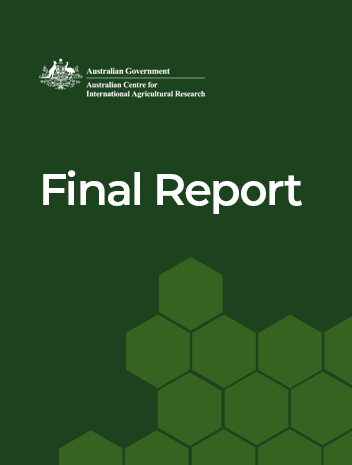- HomeHome
-
About ACIAR
- Our work
- Our people
-
Corporate information
- ACIAR Audit Committee
- Commission for International Agricultural Research
- Policy Advisory Council
- Agency reviews
- Executive remuneration disclosure
- Freedom of information (FOI)
- Gifts and benefits register
- Information publication scheme
- List of new agency files
- Contracts
- Legal services expenditure
- Privacy impact assessment register
- Commonwealth Child Safe Framework
- Benefits to Australia
- Careers
- 40 years of ACIAR
-
What we do
- Programs
- Cross-cutting areas
- Resources
- Where we work
-
Funding
- Research projects
- Fellowships
-
Scholarships
- John Allwright FellowshipScholarships to study in Australia for ACIAR partner country scientists to have Australian postgraduate qualifications
- ACIAR Pacific Agriculture Scholarships and Support and Climate Resilience Program
- Alumni Research Support Facility
- Publications
- News and Outreach
Project final report
Improving Salinity and Agricultural Water Management in the Indus Basin of Pakistan - final report
Date released
01 March 2018
Publication Code
LWR/2017/028
Overview
Waterlogging and salinisation are major impediments to the sustainability of irrigated agriculture and livelihoods of farming families across the Indus Basin of Pakistan. About 6.3 million ha in Pakistan are affected by different levels and types of salinity. Nearly half of this area is under irrigated agriculture. The drive for higher cropping intensities coupled with the lack of adequate surface water supplies has caused farmers to use poor-quality groundwater as a supplemental source of irrigation. The large scale exploitation of poor quality groundwater has increased the risks of soil salinisation and sodicity. About 4.5 million ha are already affected by secondary salinisation of which about half are located in irrigated areas. Another 1 million ha is affected by water logging (Qureshi et al., 2008). In Punjab, about 20% of the land suffers from salinity and another 20 to 30% has high groundwater levels, due to over application of surface water. Soil salinity problems are particularly serious in Sindh province where some 70 to 80% of the soil is classified as moderately or severely saline (Smedema, 2000). The southern districts of Lower Sindh, Thatta and Badin are particularly vulnerable to salinity due to waterlogging and seawater intrusion in coastal agricultural areas.
A holistic approach that incorporates the social, environmental, technical and economic aspects of salinity management is needed in Pakistan. Such an approach offers better prospects for identifying and exploring adaptation measures and building resilience for communities affected by salinity. This SRA has established the need for a holistic approach to salinity and water management, and has laid the basis for developing a shared understanding of the risks and opportunities for farming and coastal communities in salinity affected areas of the Indus Basin of Pakistan. Central to this is an understanding of the spatial and temporal dimensions of salinity in the landscape.



